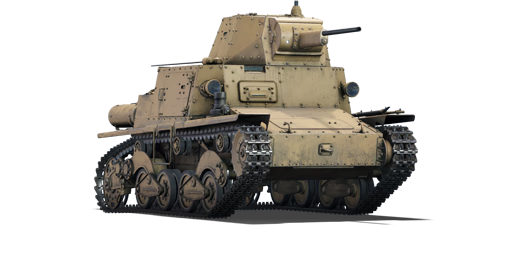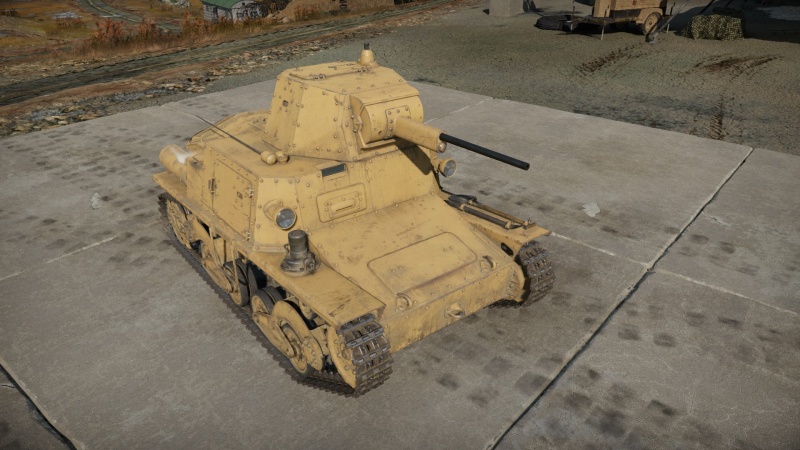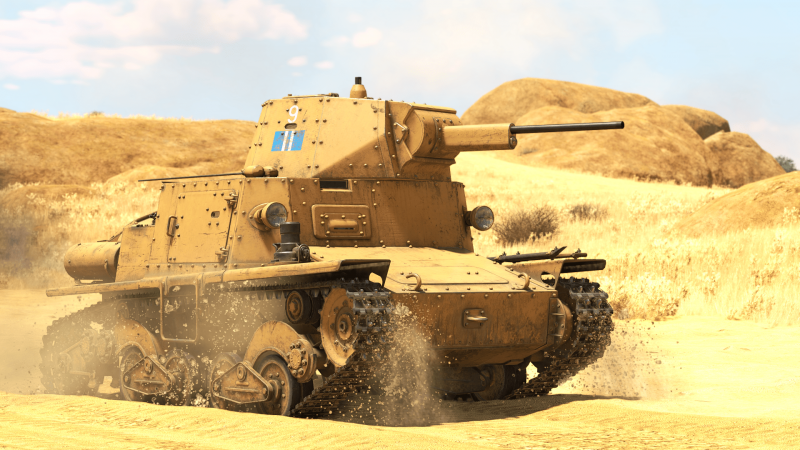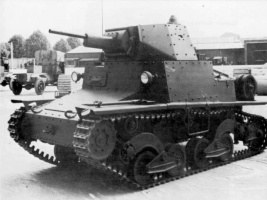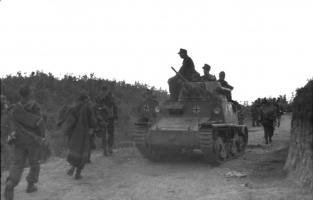L6/40
| This page is about the Italian light tank L6/40. For the premium version, see L6/40 (31 Rgt.). |
Contents
Description
The L6/40 is a tracked light tank made by Ansaldo for the Royal Italian army during the 1940s. The L6/40 was based on a heavily modified L3 chassis, keeping the two-person crew, but with an increase in firepower, protection, and mobility. It was heavily used during the occupation of the Balkans where it proved its worth. It was armed with the 20 mm Breda Mod.35 autocannon, able to fire a multitude of munitions including the Perforante mod.35 and the German PzGr 40.
Introduced in Update 1.85 "Supersonic", the L6/40's armament is more than sufficient for its battle rating as the majority of the enemies it will face do not have a lot of armour. It also has great turret rotation which is something which will be useful when flanking or when being flanked. Its mobility is also adequate; however, what it lacks in is survivability. The crew placement means that a well placed shot will instantly destroy your vehicle and, due to the lacklustre armour, you will more often than not be taken out even by low calibre guns. It's best if you stick with your more armoured allies if you wish to stay in the fight longer.
General info
Survivability and armour
Armour type:
- Rolled homogeneous armour (hull, turret, gun mantlet)
- Cast homogeneous armour (hull rear: centre housing)
| Armour | Front (Slope angle) | Sides | Rear | Roof |
|---|---|---|---|---|
| Hull | 30 mm (11°) Upper plate 15-20 mm (75°) Upper glacis 30 mm (6°) Lower plate 15 mm (70°) Lower glacis |
15 mm | 15 mm | 15-20 mm (15°) Upper glacis 10 mm Centre section 10 mm (20°) Rear section |
| Turret | 25 mm (cylindrical) Turret front 30 mm Gun mantlet 40 mm (12°) Turret frame |
15 mm (20°) | 25 mm (16°) Hatch 15 mm (16°) |
10 mm |
Notes:
- Suspension wheels and tracks are 15 mm thick while bogies are 10 mm thick.
- Mudguards are 5 mm thick.
Mobility
| Game Mode | Max Speed (km/h) | Weight (tons) | Engine power (horsepower) | Power-to-weight ratio (hp/ton) | |||
|---|---|---|---|---|---|---|---|
| Forward | Reverse | Stock | Upgraded | Stock | Upgraded | ||
| Arcade | 47 | 8 | 6.8 | 105 | 130 | 15.44 | 19.12 |
| Realistic | 43 | 7 | 60 | 68 | 8.82 | 10 | |
Modifications and economy
Armaments
Main armament
| 20 mm Breda Mod.35 | Turret rotation speed (°/s) | Reloading rate (seconds) | ||||||||||||
|---|---|---|---|---|---|---|---|---|---|---|---|---|---|---|
| Mode | Capacity (Belt) | Fire rate | Vertical | Horizontal | Stabilizer | Stock | Upgraded | Full | Expert | Aced | Stock | Full | Expert | Aced |
| Arcade | 280 (8) | 240 | -12°/+20° | ±180° | N/A | 22.8 | 31.6 | 38.4 | 42.5 | 45.2 | 7.80 | 6.90 | 6.36 | 6.00 |
| Realistic | 14.3 | 16.8 | 20.4 | 22.6 | 24.0 | |||||||||
Ammunition
- Default: API-T · HEFI-T* - This belt can be used for both roles: anti-aircraft and against lightly armoured vehicles to the detriment of a reduced rate of fire. Half the belt is composed of high-explosive fragmentation incendiary shells that will do negligible damage against armoured targets but will prove deadly against aircraft and vehicles with exposed crew
- Perforante mod.35: API-T - Intermediate belt to be used against light tanks and other vehicles from the rear. Adequate until the better PzGr 40 can be used.
- PzGr 40: HVAP-T · API-T - Highest penetrating belt, designed to deal with armoured targets . However, the penetration is very poor beyond 500 m. In close combat, aiming for modules and crew member is advised as the post-penetration damage is limited. Its effect against angled armour is limited due to the nature of the HVAP shells, but the penetration power compensates such drawback.
| Penetration statistics | |||||||
|---|---|---|---|---|---|---|---|
| Ammunition | Penetration @ 0° Angle of Attack (mm) | ||||||
| 10 m | 100 m | 500 m | 1,000 m | 1,500 m | 2,000 m | ||
| HEFI-T* | 5 | 5 | 4 | 3 | 2 | 2 | |
| API-T | 38 | 36 | 27 | 19 | 14 | 10 | |
| HVAP-T | 48 | 45 | 31 | 20 | 13 | 8 | |
| Shell details | ||||||||||||
|---|---|---|---|---|---|---|---|---|---|---|---|---|
| Ammunition | Velocity (m/s) |
Projectile mass (kg) |
Fuse delay (m) |
Fuse sensitivity (mm) |
Explosive mass (TNT equivalent) (g) |
Ricochet | ||||||
| 0% | 50% | 100% | ||||||||||
| HEFI-T* | 830 | 0.14 | 0.04 | 0.1 | 3 | 79° | 80° | 81° | ||||
| API-T | 832 | 0.14 | 1.2 | 9 | 1.7 | 47° | 60° | 65° | ||||
| HVAP-T | 1,050 | 0.1 | - | - | - | 66° | 70° | 72° | ||||
Ammo racks
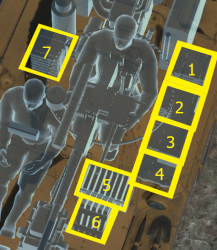
| Full ammo |
1st rack empty |
2nd rack empty |
3rd rack empty |
4th rack empty |
5th rack empty |
6th rack empty |
7th rack empty |
Visual discrepancy |
|---|---|---|---|---|---|---|---|---|
| 35 | 29 (+6) | 24 (+11) | 23 (+12) | 22 (+13) | 13 (+22) | 8 (+27) | 1 (+34) | No |
Notes:
- Ammunition is modeled as clips of 8 rounds.
- Clips disappear after having been shot/loaded.
Machine guns
| 8 mm Breda Mod. 38 | ||||
|---|---|---|---|---|
| Mount | Capacity (Belt) | Fire rate | Vertical | Horizontal |
| Coaxial | 1,536 (24) | 600 | N/A | N/A |
The small calibre of the Breda Mod. 38 machine gun makes it largely ineffective against all armoured vehicles but the ones with an open compartment. It still can be used to ping targets as a rangefinding help or to mow down minor obstacles blocking the cannon's line of sight.
Usage in battles
- Combat tactics
The L6/40 possesses a level of versatility which allows it to play in a variety of roles with varying efficiency. As a frontline tank, one must maintain a short engagement distance (up to 200 m if possible) and exploit its small size to hide in almost all types of cover. The autocannon's efficiency will allow the player to dispatch of most enemies even frontally, and can knock out cannon barrels and tracks if it is unable to.
Flanking is another way to best use the tank's advantages. It is relatively mobile and the autocannon will be more reliable against the side armour of the enemy vehicles. Additionally, by flanking, one will artificially increase the L6/40's survivability, as it is not going to be the main target of fire in the initial stages of the player's ambush. This removes the reliance on the protection which, as previously mentioned, is not an aspect that will consistently save it.
Playing at range and sniping is almost pointless as the armament quickly loses penetration over range and struggles to penetrate even lightly armoured opponents.
Whichever playstyle one chooses, it is important to always play to the strengths of the vehicle, mainly the automatic armament and reactive turret traverse.
- Notable enemies
- Heavily armoured tanks that can negate the 20 mm rounds such as the FCM.36, S.35, and Valentine Mk I.
- Tanks with sloped armour that can ricochet the rounds such as the H.39, T-60, T-70, or T-80.
- How to defeat a L6/40
Stay at a distance of at least 500 m to negate its firepower. If the L6/40's armour profile is unangled, fire at the front plate underneath the turret to guarantee the incapacitation of the crew. If the tank is heavily angled, a shot into the very thin side armour will likely penetrate. Finally, if the L6/40 is adequately angled and neither the front nor side can be penetrated, the player's best shot is to fire at the corner plate between the front and side, which normalizes upon angling. This is one's only chance to fire at a flat plate in this situation.
Pros and cons
Pros:
- Potent armament with good penetration and damage output
- Great turret rotation
- Good acceleration
- Adequate mobility
Cons:
- Poor suspension damping, it takes about 2 seconds to settle after stopping the vehicle
- Limited crew of 2
- Low rate of fire
- Limited magazines of 8 rounds
- Hull side can be penetrated by 0.50 cal machine guns
History
The story of the L6/40 began during the late 1930s, Ansaldo assisted by FIAT were creating a multitude of prototypes in the hopes that it would take over many of the roles of the L3 Tankette. Ansaldo would mainly take on the idea and the doctrine of mountain combat when designing new vehicles; due to the Italian involvement in WW1, they thought that allowing a vehicle to be easily transported to the tops of high mountains would ultimately give them the upper hand if in the future there was a chance for another world war to take place.
This is exactly what they did with the L6/40: they kept the vehicle as light as possible. It would be based on a heavily modified L3 chassis, keeping the two-person crew, but with increased firepower, protection, and mobility. The L6/40 as previously stated, would be designed with mountain-worthy combat specifications in mind. The vehicle had a width of 1.8 metres, this allowed it to travel on all the mountain roads and mule trails that other vehicles of the era would have a much harder time passing through. Its weight would overall be 6.84 tonnes, its name stood for L for Light, 6 for its weight, and 40 for its year of adoption in the Royal Italian Army.
By the time it was accepted for service in early 1940, it was adequate as a reconnaissance tank and as a general support vehicle to supplement infantry and other armoured columns when travelling. However, when it entered general service in 1942 it was hopelessly obsolete, mainly due to the fact that the Italian industry was not able to compete with other nations like the USSR and the USA. Italy created many designs for armoured vehicle during the era too, so it wasn't really a priority for them to try and rectify the vehicle by improving on it without wasting precious resources into the project. In fact, after 283 units had been built, it was cancelled in favour of the Semovente 47/32.
The main characteristic that made the L6/40 stand-out whilst it was being designed was its mobility, it used a FIAT SPA Tipo 18vt liquid-cooled engine which allowed the vehicle to reach speeds of up to 42 km/h. The L6/40's range was 200 km. In terms of armament, the L6/40 used the 20 mm Breda 35, it was installed on a multitude of vehicles at the time. The cannon was able to fire rounds such as the Italian Perforante mod.35 and the German PzGr.40.
In terms of service, the L6/40 was used in the Raggruppamento Esplorante Corazzato (RECo), the divisional-level armoured reconnaissance task forces found in the order of battle of armoured and motorized divisions, and in several independent reconnaissance units deployed in 4-car platoons. In total, 72 were sent to North Africa, and 55 went to Russia on March 1942, where they equipped the 67th Battaglione Motocorazzato Bersaglieri (lightly armoured battalion) in the 3rd Celere (Cavalry) Division. They were the heaviest Italian tanks used on that front. The battalion was destroyed in December 1942 during fighting on the Don River. L6/40 was also employed in Yugoslavia, by the San Guisto light armoured squadron-group of the 1st Celere Division. The L6/40 would proceed to be used all the way to the end of the war, but also would be extensively used post-war by the Celere police force. Some may have survived and remained in service in subsequent years. Some L6/40's have also survived to this day, one can be found in Legnano in Italy, one is in the inventory of the Kubinka Tank Museum in Russia, and another is preserved in the Arms Museum in the castle of Gjirokastër in Albania.
Media
- Skins
- Videos
See also
- Other vehicles of similar configuration and role
External links
- [Wikipedia] L6/40 tank
- [Tanks Encyclopedia] FIAT-Ansaldo L6/40
- [Military Factory] Carro Armato L6/40
| FIAT-Ansaldo | |
|---|---|
| Autoblindo | AB 41 · AB 43 |
| Light Tanks | L6/40 · L6/40 (31 Rgt.) |
| Medium Tanks | Celere Sahariano |
| M11/39 | M11/39 |
| M13/40 | M13/40 (I) · M13/40 (II) · M13/40 (III) |
| M14/41 | M14/41 · M14/41 (47/40) |
| M15/42 | M15/42 |
| P40 | P40 · P40 "G.C. Leoncello" |
| Tank Destroyers | |
| L3/33 | L3/33 CC |
| Semovente L40 | 47/32 L40 |
| Semovente M41 | 75/18 M41 · 75/32 M41 · 90/53 M41M |
| Semovente M42 | 75/34 M42 |
| Semovente M43 | 105/25 M43 · M43 "G.C.Leoncello" · 75/34 M43 · 75/46 M43 |
| SPAAs | M42 Contraereo |
| Italy light tanks | |
|---|---|
| Italy | |
| L6/40 | L6/40 · L6/40 (31 Rgt.) |
| M11/39 | M11/39 |
| Autoblindo | AB 41 · AB 43 |
| Fiat 6614/6616 | FIAT 6614 · AUBL/74 · AUBL/74 HVG |
| R3 Capraia | R3 T106 FA |
| Centauro | Centauro I 105 · Centauro I 105 R · Centauro I 120 · Centauro RGO · VRCC |
| Freccia | VBC (PT2) · Freccia |
| Dardo | Dardo · VCC-80/60 · VCC-80/30 |
| Other | C13 T90 |
| USA | ▄M3A3 · ▄M24 · ▄M18 |
| Hungary | |
| WWII | Csaba · Toldi IIA |
| Post | ◔BTR-80A · KF41 |


